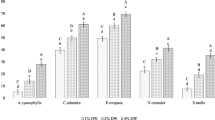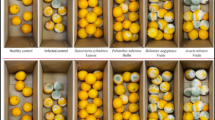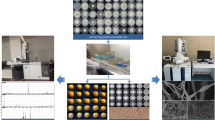Abstract
The present reviewed work on antifungal properties of EOs against following fungal pathogens of anthracnose disease is critically appraised over the period of last 16 years (2000–2016) that encompass both etiology and epidemiology of anthracnose in tropical fruits; current status of the main EOs and their specific volatile compounds such as terpenes, aromatic compounds, nitrogenous compounds were identified for their antifungal properties, when used at specific minimum inhibition concentration against species of the Colletotrichum genera of anthracnose disease; mechanisms of action of these major EOs for their antifungal activity were discussed. The major inferences drawn from this critical appraisal reviewed are the antifungal properties and the good fumigant nature of the above-mentioned essential oils and their specific volatile compounds from various plant species that inhibits postharvest fungal growth of Colletotrichum species such as Colletotrichum gloeosporioides Penz., Colletotrichum acutatum Colletotrichum fragaria, Colletotrichum musae of anthracnose disease in different tropical fruits in in vitro conditions. Till now, the researchers of the reported work reviewed did not pay attention toward further characterization of bioactive molecules with antifungal properties either from these listed EOs or their specific bioactive compounds. No cited work reported on in vitro screening and testing for their individual and synergistic effects even on in vivo testing their efficacies as the biochemical fungicide against said pathogenic fungal species of anthracnose. This reviewed knowledge on above topic could be used as future research tools to trace out the biochemical fungicides from various medicinal and aromatic plant sources as the alternative to synthetic chemical fungicides.




Similar content being viewed by others
References
Abd-Aiiam MA, Haggag WM (2013) Use of some plant essential oils as post-harvest botanical fungicides in the management of anthracnose disease of mango fruits (Mangifera indica L.) caused by Colletotrichum gloeosporioides (Penz). Int J Agric For 3:1–6. doi:10.5923/j.ijaf.20130301.01
Ahmed S (1987) In: Grainge M, Ahmed S (eds) Handbook of plants with pest control properties-preface. Wiley, Hoboken
Ahmet C, Saban K, Hamdullah K, Ercan K (2005) Antifungal properties of essential oil and crude extracts of Hypericum linarioides Bosse. Biochem Syst Ecol 33:245–256. doi:10.1016/j.bse.2004.08.006
Amarjeet Kumar and Kudachikar (2017a) Figure 1: Colletotrichum species. (a. Colletotrichum gloeosporioides fungal growth plate, b. Colletotrichum gloeosporioides spore, and c. Colletotrichum coccodes fungal growth plate, d. Colletotrichum coccodes spore. Unpublished data
Amarjeet Kumar and Kudachikar (2017b) Figure 3: (a, b, c, d, and e.) Anthracnose disease in Mango, Tomato and Banana fruits. Unpublished data
Amiri A, Dugas R, Pichot AL, Bompeix G (2008) In vitro and In vivo activity of eugenol oil (Eugenia caryophylata) against four important postharvest apple pathogens. Int J Food Microbiol 126(1):13–19. doi:10.1016/j.ijfoodmicro.2008.04.022
Anaruma ND, Schmidt FL, Duarte MCT, Figueira GM, Delarmelina C, Benato EA, Sartoratto A (2010) Control of Colletotrichum gloeosporioides (Penz.) Sac. in yellow passion fruit using Cymbopogon citratus essential oil. Braz J Microbiol 41:66–73. doi:10.1590/S1517-83822010000100012
Andrade WP, Vieira GHC (2016) Effect of essential oils on in vitro anthracnose and in fruits of the papaya plant. Rev Bras Plant Med 18(1):367–372. doi:10.1590/1983-084X/15_089
Aquino CF, Sales NLP, Soares EPS, Martins ER, Costa CA (2014) Chemical composition and in vitro activity of three essential oils on Colletotrichum gloeosporioides from passion fruit. Rev Bras Plant Med 16(2):329–336. doi:10.1590/1983-084X/12_115
Barrera-Necha LL, Bautista-Baños S, Flores Moctezuma HE, Estudillo AR (2008) Efficacy of essential oils on the conidial germination, the growth of Colletotrichum gloeosporioides (Penz.) and control of postharvest diseases in papaya (Carica papaya L.). Plant Pathol J 7(2):174–178. doi:10.1016/j.postharvbio.2010.03.008
Bazaka K, Jacob MV, Chrzanowski W, Ostrikov K (2015) Antibacterial surfaces: natural agents, mechanisms of action, and plasma surface modification. J Royal Soc Chem 5:48739–48759. doi:10.1039/c4ra17244b
Been J, Akhila R, Abraham E (2007) Antimicrobial activity and chemical composition of essential oil from Hedychium coronarium. Phytother Res 21(5):439–443. doi:10.1002/ptr.2091
Bellerbeck VG, De Roques CG, Bessiere JM, Fonvieille JL, Dargent R (2001) Effect of Cymbopogonnardus (L.) W.Watson essential oil on the growth and morphogenesis of Aspergillus niger. Can J Microbiol 47(1):9–17. doi:10.1139/cjm-47-1-9
Betts TJ (2001) Chemical characterization of the different types of volatile oil constituents by various solute retention ratios with the use of conventional and novel commercial gas chromatographic stationary phases. J Chromatogr A 936(1–2):33–46
Beye F (1978) Insecticides from the vegetable kingdom. Plant Res Dev 7:13–31
Bhardwaj J, Seth MK, Jameel A, Dinesh C (2014) Antifungal efficacy of essential oils against common bean anthracnose caused by Colletotrichum lindemuthianum. IJSRR 3(4):22–29
Bishop CD, Thornton IB (1997) Evaluation of the antifungal activity of the essential oils of Monardaci triodora var. citriodora and Melaleuca alternifolia on the postharvest pathogens. J Essential Oil Res 9:77–82. doi:10.1080/10412905.1997.9700718
Bosquez-Molinaa E, Ronquillo-de Jesús E, Bautista-Banos S, Verde-Calvoa JR, Morales-López J (2010) Inhibitory effect of essential oils against Colletotrichum gloeosporioides and Rhizopus stolonifer in stored papaya fruit and their possible application in coatings. Postharvest Biol Technol 57:132–137. doi:10.1016/j.postharvbio.2010.03.008
Bowles EJ (2003) Chemistry of aroma therapeutic oils. Allen and Unwin, Crows Nest. ISBN 174114-051X
Burt Sara (2004) Essential oils: their antibacterial properties and potential application in foods. Int J Food Microbiol 94:223–253. doi:10.1016/j.ijfoodmicro.2004.03.022
Carson CF, Mee BJ, Riley TV (2002) Mechanism of action of Melaleuca alternifolia (tea tree) oil on Staphylococcus aureus determined by time-kill, lysis, leakage and salt tolerance assays and electron microscopy. Antimicrob Agents Chemother 46(6):1914–1920. doi:10.1128/AAC.46.6.1914-1920.2002
Chen Y, Zeng H, Tian J, Ban X, Ma B, Wang Y (2013) Antifungal mechanism of essential oil from Anethum graveolens seeds against Candida albicans. J Medical Microbio 62:1175–1183. doi:10.1099/jmm.0.055467-0
Cid-Perez TS, Torres-Munoz JV, Nevarez-Moorillon GV, Palou E, Lopez-Malo A (2016) Chemical characterization and antifungal activity of Poliomintha longiflora Mexican oregano. J Essent Oil Res 28(2):157–165. doi:10.1080/10412905.2015.1083490
Combrinck S, Regnier T, Kamatou GPP (2011) In-vitro activity of eighteen essential oils and some major components against common postharvest fungal pathogens of fruit. Ind Crops Prod 33(2):344–349. doi:10.1016/j.indcrop.2010.11.011
Cristani M, d’Arrigo M, Mandalari G, Castelli F, Sarpietro MG, Micieli D, Venuti V, Bisignano G, Saija A, Trombetta D (2007) Interaction of four monoterpenes contained in essential oils with model membranes: implications for their antibacterial activity. J Agric Food Chem 55(15):6300–6308. doi:10.1021/jf070094x
Croteau R, Kutchan TM, Lewis NG (2000) Natural products (secondary metabolites). In: Buchanan B, Gruissem W, Jones R (eds) Biochemistry and molecular biology of plants. American Society of Plant Physiologists, Rockville
Daferera DJ, Ziogas BN, Polissiou MG (2000) GC–MS analysis of essential oils from some Greek aromatic plants and their fungitoxicity on Penicillium digitatum. J Agric Food Chem 48:2576–2581. doi:10.1021/jf990835x
Dehghan G, Solaimanian R, Shahverdi AR, Amin G, Abdollahi M, Shafiee A (2007) Chemical composition and antimicrobial activity of essential oil of Ferula szowitsiana D.C. Flavour Fragr J 22(3):224–227. doi:10.1002/ffj.1789
Diodge EM (1932). Black spot of mangoes farming South Africa. Plant Pathol Bull 7:89–91. Dictionary of the fungi. 8th edn. International Mycological Institute, CAB
Dixit SN, Chandra H, Tiwari R, Dixit V (1995) Development of botanical fungicide against blue mold of mandarins. J Stored Prod Res 31:165e172. doi:10.1016/0022-474X(94)00041-Q
Dorman HJD, Deans SG (2000) Antimicrobial agents from plants: antibacterial activity of plant volatile oils. J Appl Microbiol 88:308–316. doi:10.1046/j.1365-2672.2000.00969.x
Elshafie HS, Ghanney N, Mang SM, Ferchichi A, Camele I (2016) An in vitro attempt for controlling severe phytopathogens and human pathogens using essential oils from mediterranean plants of genus Schinus. J Med Food 19(3):266–273. doi:10.1089/jmf.2015.0093
Farag RS, Daw ZY, Abo-Raya SH (1989) Influence of some spice essential oils on Aspergillus parasiticus growth and production of aflatoxin in a synthetic medium. J Food Sci 54:74–76. doi:10.1111/j.1365-2621.1989.tb08571.x
Feng W, Zheng X (2007) Essential oils to control Alternaria alternata in vitro and in vivo. Food Control 18:1126–1130. doi:10.1016/j.foodcont.2006.05.017
Gautam AK (2014) Colletotrichum gloeosporioides: biology, pathogenicity and management in India. J Plant Physiol Pathol 2(2):1–11. doi:10.4172/2329-955X.1000125
Hajhashemi V, Ghannadi A, Sharif B (2003) Anti-inflammatory and analgesic properties of the leaf extracts and essential oil of Lavandula angustifolia Mill. J Ethnopharmacol 89:67–71. doi:10.1016/S0378-8741(03)00234-4
Hidalgo PJ, Ubera JL, Santos JA, LaFont F, Castelanos C, Palomino A, Roman M (2002) Essential oils in Culamintha sylvatica Bromf. sp. ascendens (Jorden) PW Ball wild and cultivated productions and antifungal activity. J Essential Oil Res 14:68–71. doi:10.1080/10412905.2002.9699768
Hyde KD, Cai L, McKenzie EHC, Yang YL, Zhang JZ, Prihastuti H (2009) Colletotrichum: a catalog of confusion. Fungal Div 39:1–17
Isman MB (2000) Plant essential oil for pest and disease management. Crop Prot 19:603–608. doi:10.1016/S0261-2194(00)00079-X
Jing L, Lei Z, Li L, Xie R, Xi W, Guan Y, Sumner LW, Zhou Z (2014) Antifungal Activity of Citrus Essential Oils. J Agric Food Chem 62:3011–3033. doi:10.1021/jf5006148
Kabara JJ (1991) Phenols and chelators. In: Rusell NJ, Gould GW (eds) Food preservatives. Blackie, London, pp 200–214
Karmen V, Bojana B, Margareta V, Franc P (2003) Effect of the antifungal activity of oxygenated aromatic essential oil compounds on the white-rot Trametes Versicolor and the brown-rot Coniophora puteana. Int Biodeter Biodegrad 51(1):51–59
Kauser AG (1959) Malformation of inflorescence in mango. Punjab Fruit J 22:19–21
Kirk PM, Cannon PF, Minter DW, Stalpers JA (2008) The dictionary of the fungi, 10th edn. CABI Bioscience, UK
Kordali S, Kotan R, Mavi A, Cakir A, Ala A, Yildirim A (2005) Determination of the chemical composition and antioxidant activity of the essential oil of Artemisia dracunculus and the antifungal and antibacterial activities of Turkish Artemisia absinthium, A. dracunculus, Artemisia santonicum, and Artemisia spicigera essential oils. J Agric Food Chem 53:9452–9458. doi:10.1021/jf0516538
Koul O, Walia S, Dhaliwal GS (2008) Essential oils as green pesticides: potential and constraints. Biopestic Int 4(1):63–84
Kurita N, Koike S (1983) Synergistic antimicrobial effect of ethanol, sodium chloride, acetic acid and essential oil components. Agric Biol Chem 47:67–75. doi:10.1080/00021369.1983.10865580
Kurita N, Miyaji M, Kurane R, Takahara Y (1981) Antifungal activity of components of essential oils. Agric Biol Chem 45:945–952. doi:10.1080/00021369.1981.10864635
López-Malo A, Alzamora SM, Guerrero S (2000) Natural antimicrobials from plants. In: Alzamora SM, Tapia MS, López-Malo A (eds) Minimally processed fruits and vegetables-fundamental aspects and applications. Aspen Publishers Inc, Gaithersburg, pp 237–263
Lucini EI, Zunino MP, Lopez ML, Zygadlo JA (2006) Effect of monoterpenes on lipid composition and sclerotial development of Sclerotium cepivorum Berk. J Phytopathol 154:441–446. doi:10.1111/j.1439-0434.2006.01126.x
Mackenzie SJ, Seijo TE, Legard DE, Timmer LW, Peres NA (2007) Selection for pathogenicity to strawberry in populations of Colletotrichum gloeosporioides from native plants. Phytopathology 97:1130–1140. doi:10.1094/PHYTO-97-9-1130
Maqbool M, Ali A, Peter GA, Mahmud Tengku MM, Siddiqui Y, Zahida N (2011) Postharvest application of gum arabic and essential oils for controlling anthracnose and quality of banana and papaya during cold storage. Postharvest Biol Technol 62:71–76. doi:10.1016/j.postharvbio.2011.04.002
Martin MP, Garcia Figueres F (1999) Colletotrichum acutatum and C. gloeosporioides cause anthracnose on olives. Eur J Plant Pathol 105(8):733–741
Mihaliak CA, Gershenzo J, Croteau R (1991) Lack of rapid monoterpene turnover in rooted plants, implications for theories of plants chemicals defenses. Oceologia 87:373–376. doi:10.1007/BF00634594
Mozaina K, Mario RT, Charles LW, Franck ED, Kevin KS, David EW (2001) Phytotoxic and fungi toxic activities of the essential oil of kenaf (Hibiscus cannabinus L.) leaves and its composition. J Agric Food Chem 49:3768–3771. doi:10.1021/jf0101455
Munch S, Lingner U, Floss DS, Ludwig N, Sauer N, Deising HB (2008) The hemibiotrophic lifestyle of Colletotrichum species. J Plant Physiol 165:41–51. doi:10.1016/j.jplph.2007.06.008
Naigre R, Kalck P, Roques C, Roux I, Michel G (1996) Comparison of antimicrobial properties monoterpenes and their carbonylated products. Planta Med 62:275–277. doi:10.1055/s-2006-957877
Omidbeygi M, Barzegar M, Hamidi Z, Naghdibadi H (2007) Antifungal activity of thyme, summer savory and clove essential oils against Aspergillus flavus in liquid medium and tomato paste. Food Control 18:1518–1523. doi:10.1016/j.foodcont.2006.12.003
Oxenham SK (2003) Classification of an Ocimum basilicum germplasm collection and examination of the antifungal effects of the essential oil of basil. Ph.D. thesis, University of Glasgow, Glasgow, UK
Ozek G, Demirci F, Ozek T, Tabanca N, Wedge DE, Khan SI, Baser KH, Duran A, Hamzaoglu E (2010) Gas chromatographic-mass spectrometric analysis of volatiles obtained by four different techniques from Salvia rosifolia Sm., and evaluation for biological activity. J Chromatogr A 1217(5):741–748. doi:10.1016/j.chroma.2009.11.086
Palhano FL, Vilches TTB, Santos RB, Orlando MTD, AV J, Fernandes PMB (2004) Inactivation of Colletotrichum gloeosporioides spores by high hydrostatic pressure combined with citral or lemongrass essential oil. Int J Food Microbiol 95:61–66. doi:10.1016/j.ijfoodmicro.2004.02.002
Perry NS, Bollen C, Perry EK, Ballard C (2003) Salvia for dementia therapy: review of pharmacological activity and pilot tolerability clinical trial. Pharmacol Biochem Behav 75(3):651–659. doi:10.1016/S0091-3057(03)00108-4
Pichersky E, Noel JP, Dudareva N (2006) Biosynthesis of plant volatiles: nature’s diversity and ingenuity. Science 311:808–811. doi:10.1126/science.1118510
Pinto E, Pina-Vaz C, Salgueiro L, Gonçalves MJ, Costa-de-Oliveira S, Cavaleiro C, Palmeira A, Rodrigues A, Martinez-de-Oliveira J (2006) Antifungal activity of the essential oil of Thymus pulegioides on Candida, Aspergillus and dermatophyte species. J Med Microbiol 55:1367–1373. doi:10.1099/jmm.0.46443-0
Pitkethley R, Conde B (2007) Mango anthracnose. http://www.nt.gov.au/d/Content/File/p/Plant Pest/604.pdf
Ploetz RC, Freeman S (2009) Foliar, floral and soil borne diseases. In: Litz RE (ed) The mango: botany, production, and uses, 2nd edn. CABI Publishing, UK, pp 231–302
Prakash B, Singh P, Kedia A, Dubey NK (2012) Assessment of some essential oils as food preservatives based on antifungal, anti-aflatoxin, antioxidant activities and in vivo efficacy in food system. Food Res Int 49:201–208. doi:10.1016/j.foodres.2012.08.020
Raccach M (1984) The antimicrobial activity of phenolics antioxidant in foods: a review. J Food Saf 6(3):141–170. doi:10.1111/j.1745-4565.1984.tb00479.x
Regnier T, Plooy W, Combrinck S, Botha B (2008) Fungi toxicity of Lippia Scaberrima essential oil and selected terpenoid component on two mango postharvest spoilage pathogen. Postharvest Biol Technol 48:254–258. doi:10.1016/j.postharvbio.2007.10.011
Rojas EI, Rehner SA, Samuels GJ, Van Bael SA, Herre EA (2010) Colletotrichum gloeosporioides s.l. associated with Theobroma cacao and other plants in Panama: multilocus phylogenies distinguish pathogen and endophyte clades. Mycologia 102(6):1318–1338. doi:10.3852/09-244
Sellamuthu PS, Mafune M, Sivakumar D, Soundy P (2013a) Thyme oil vapor and modified atmosphere packaging reduce anthracnose incidence and maintain fruit quality in avocado. J Sci Food Agri. 93:3024–3031. doi:10.1002/jsfa.6135
Sellamuthu PS, Sivakumar D, Soundy P, Korsten L (2013b) Essential oil vapors suppress the development of anthracnose and enhance defense related and antioxidant enzyme activities in avocado fruit. Postharvest Biol Technol 81:66–72. doi:10.1016/j.postharvbio.2013.02.007
Sharma PN, Kaur M, Sharma OP, Sharma P, Pathania A (2005) Morphological, pathological and molecular variability in Colletotrichum capsici, the cause of fruit rot of chillies in the subtropical region of north-western India. J Phytopathol 153(4):232–237. doi:10.1111/j.1439-0434.2005.00959.x
Sharma N, Tripathi A (2006) Effects of (Citrus sinensis L.) Osbeck epicarp essential oil on growth and morphogenesis of (Aspergillus niger L.) Van Tieghem. Microbiological Res. 163:337–344. doi:10.1016/j.micres.2006.06.009
Singh R, Tripathi P (2015) Cinnamomum zeylanicum essential oil in the management of anthracnose of banana fruits. JIPBS 2(3):290–299
Smid EJ, Wittey D, De Vrees O, Gorris LMG (1994) Use of secondary plant metabolites for the control of post-harvest fungal diseases on flower bulbs. Acta Hortic. 368:523–530
Tabanca N, Demirci B, Baser KHC, Mincsovics E, Khan SI, Jacob MR, Wedge DE (2007) Characterization of volatile constituents of Scaligeria tripartita and studies on the antifungal activity against phytopathogenic fungi. J Chromatogr B 850(2007):221–229. doi:10.1016/j.jchromb.2006.11.041
Taiz L, Zeiger E (2010) Plant physiology, 5th edn. Sinauer Associates Inc, Sunderland, p 891
Tepe B, Daferera D, Sokmen A, Sokmen M, Polissiou M (2005) Antimicrobial and antioxidant activities of the essential oil and various extracts of Salvia tomentosa Miller (Lamiaceae). Food Chem 90(4):333–340. doi:10.1016/j.foodchem.2003.09.013
Tripathi P, Dubey NK (2004) Exploitation of natural products as an alternative strategy to control postharvest fungal rotting of fruit and vegetables. Postharvest Biol Technol 32:235–245. doi:10.1016/j.postharvbio.2003.11.005
Veluri R, Weir TL, Bais HP, Stermitz FR, Vivanco JM (2004) Phytotoxic and antimicrobial activities of catechin derivatives. J Agric Food Chem 52(5):1077–1082. doi:10.1021/jf030653+
Viuda-Martos M, Ruiz-Navajas Y, Fernández-López J, Pérez Álvarez JA (2007) Antifungal activities of thyme, clove and oregano essential oils. J Food Saf 27:91–101. doi:10.1111/j.1745-4565.2007.00063.x
Viuda-Martos M, Ruiz-Navajas Y, Fernández-López J, Pérez-Álvarez J (2008) Antifungal activity of lemon (Citrus lemon L.), mandarin (Citrus reticulata L.), grapefruit (Citrus paradisi L.) and orange (Citrus sinensis L.) essential oils. Food Control 19:1130–1138. doi:10.1016/j.foodcont.2007.12.003
Wink M, Schimmer O (2010) Molecular modes of action of defensive secondary metabolites. In: Wink M (ed) Functions and biotechnology of plant secondary metabolites. Wiley-Blackwell, Chichester, pp 21–161
Yilmaz A, Ermis E, Boyraz N (2016) Investigation of in vitro and in vivo antifungal activities of different plant essential oils against postharvest apple rot diseases-Colletotrichum gloeosporioides, Botrytis cinerea and Penicillium expansum. J Food Safety and Food Quality 67(5):113–148. doi:10.2376/0003-925X-67-122
Acknowledgements
The authors are thankful to Director, CSIR-CFTRI, Mysuru for his keen interest, constant encouragement and CFTRI library staff for their help in collecting data and technical assistance to use search engines. This research review work undertaken as part of the CSIR-Network project-Agropathy (BSC0105) funded by Council of Scientific and Industrial Research (CSIR), New Delhi.
Author information
Authors and Affiliations
Corresponding author
Ethics declarations
Conflict of interest
I, Dr. V.B Kudachikar, the corresponding author of the manuscript, on the behalf of all the co-authors hereby undertake that there is no conflict of interest in the manuscript of the critical review paper for publication.
Rights and permissions
About this article
Cite this article
Kumar, A., Kudachikar, V.B. Antifungal properties of essential oils against anthracnose disease: a critical appraisal. J Plant Dis Prot 125, 133–144 (2018). https://doi.org/10.1007/s41348-017-0128-2
Received:
Accepted:
Published:
Issue Date:
DOI: https://doi.org/10.1007/s41348-017-0128-2




